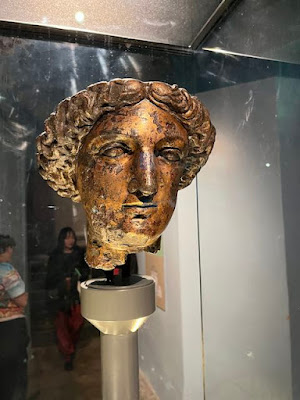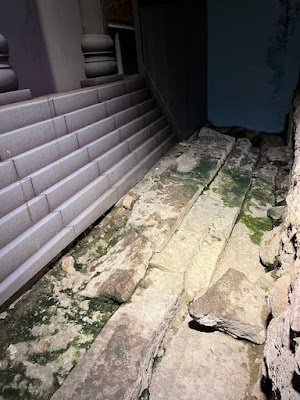We visited the Roman baths in the City of Bath today. They are a UNESCO World Heritage Site and were very cool. We had our own audio guides and could move at our own pace through the exhibits, which is good because the three of us love museums and soaked in everything we could (no pun intended). We made a good choice to arrive first thing in the morning. It got more and more crowded after our arrival.
We started at the top level (modern day street level) and then worked our way down to the excavated levels below. This was the great bath. It's still filled with flowing spring water today. The water is bathtub warm (we weren't supposed to put our hands in, but you know...we did). There's algae growing in it, thus the green color. When it was used in Roman times, they would drain it regularly by diverting the water and would clean it out. It was lead-lined with a seal so tight that it still holds today (2000 years later).
The baths date back to before 70 AD. This stone holds the earliest inscription found among the artifacts and dates to 76 AD. The baths were actively used from that time to about 400 AD when the Roman empire collapsed and they were left in disrepair. The water works were not maintained and the site flood and got covered in mud and was eventually built over.

The Baths are directly next to the Abbey and Cathedral. When the site was rediscovered by the British in 1775, the great bath was restored and the statues of various Roman emperors were added along the roof line to create a more 'Roman vibe'. This is one of ten or so that were added. They are pretty weathered even though they are just 200 years old instead of 2000.
This is a model of the buildings on the site from Roman times. They believed the hot springs were the home of the Goddess Minerva and built a temple to her along with the spring fed baths. The spring flows with 1 million liters/day at a temperature of 46 C (114 F) which cools as it is piped throughout the complex. (The Great bath is about 95 F.) Originally the Romans mixed genders when bathing, but a some point they began having men's and women's facilities on either side of the Great bath. These included Calderiums (dry saunas), frigidariums (cold water baths), and other rooms.
These sculptures were above the main entrance. Most believe that the head in the center is Medusa, although it appears male and could have been Neptune. It's kind of remarkable that so many pieces were still in tact.
There was a huge collection of bagged coins that were discovered in a Roman building 150 meters from the Baths. They were in 8 leather bags and had coins dating from 32 BC to 275 AD. With over 17,000 coins, it's one of the largest Roman hoards ever discovered.
They also found a lot of coins that had been tossed into the springs as an offering to the goddess. Some were pre-Roman and were made by two local tribes. These tribes were actually partly responsible for naming the goddess for whom the temple was built. She was Sulis to the locals and Minerva to the Romans, so Sulis Minerva was worshipped here.
People came from all over the Roman empire. Those with means were buried in lead lined caskets. Analysis of this body shows that he was from Syria (!) and was wealthy enough to have honey in his diet (you could tell from the teeth).
This was a sculpture of a rich woman of the times wearing her hair in the newest style from Rome. All the hair from the back was pulled forward and through some netting in little poofs to create the big hair in the front. It probably took over an hour for a servant to create this style. The video behind was a fun recreation with live actors.
There were a number of funerary stones that tell history of important people at the time. This was for a priest of the goddess. It was uniquely shaped as an alter stone in tribute to his temple duties.
I was very surprised that three of the four cornerstones for the alter were still on site. Two were standing in place and the third was laying to the side of the alter (below). These were found in excavations in 1965. It is likely that the stones were painted at the time.
The person who studied the organs of the animals who were sacrificed was call the Haruspex. They would tell the person who offered the sacrifice what the omens were for their travel, etc. The writing on the stone above says "For the goddess Sulis, Lucius Marcius Menor Haruspex gives this gift". Much of the writing is done in abbreviations, for example, the last line is "D D" (donis dedit ?) gives this gift. Not only to you have to figure out letters that are worn by time, but in a different language, AND that are abbreviated. I don't know how they do it.
This is the bronze face of the goddess Sulis Minerva. Her statue was in the small temple on the site (the alter was out in the courtyard). The face had several layers of gold plating and likely needed polishing regularly due to the soot from the torches lighting the temple space. Only the priests could go inside the temple.
The bottom three steps of the original temple, still in place. The temple was likely destroyed by Christians in 500 AD. The Bath Cathedral was built very nearby in the 900s.
These were curses that were scratched on sheets of lead and thrown into the springs as petitions for the goddess. They were pretty petty: May the person who stole my bronze pot be utterly cursed. Lots of dire requests for thefts of small every day items.
The museum had a number of well curated items. I didn't photograph most of them, but was intrigued by the pretty decorations on the handle of this small pot.
This is an overflow drain from one of the baths above. It was they only part of the site that gave you a sense of the flow of water moving through here. The orange is from the iron in the water.
The water drains away from the site through an underground passage (high enough to stand in) that flows to the River Avon a few hundred meters away.
These were some gemstones that were found in the drains during excavation. They were about pinky nail sized and quite pretty. Its not known whether they were deliberately tossed into the spring as an offering, or were lost by wealthy bathers. They date to Roman times.
Although the water was murky, the reflections were pretty neat.
The baths were roofed over during Roman times, but open during the 1800s. The view of the nearby cathedral is quite pretty.
This is a 2000 year old lead pipe that moved water from the spring to the women's bath at the other end of the complex.
This is part of the remaining roof arch.
The bricks for the roof were made hollowed out to reduce the weight.
This was the frigidarium - cold water bath
This was the subfloor of the dry sauna - a stone floor would sit atop these pillars and a furnace would heat air that was circulated underneath. The floor was likely too hot to stand on with bare feet.
This is the hottest part of the spring. In the 1800s it used to have a higher level floor (where the ledge is just above current water level). You can see the orange coloration where the high water mark used to be. There are also metal rings on the walls to hold you close to the wall where the water was a little cooler. The water was at the lower level seen here during Roman times. If you look closely, you can see little bubbly ripples in the center. These are gas bubbles coming up with the spring water.
The waters were used for healing, both to soak in and to ingest. Some treatments recommended drinking 5 liters of water...BEFORE breakfast! We got to sample the water at the end of the tour. It was hot and tasted like a bloody nose to me (the iron). Ick. I can't imagine drinking even 1 liter.



























No comments:
Post a Comment